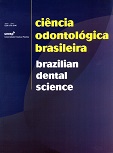Prevalência de gengivite e periodontite em crianças de 3 a 5 anos na cidade de
DOI:
https://doi.org/10.14295/bds.2003.v6i4.580Abstract
O presente estudo avaliou a prevalência de gengivite e periodontite em 518 crianças de três a cinco anos nacidade de Aracaju (SE). Ao exame clínico foram coletados dados relativos ao acúmulo de placa bacteriana,
sangramento gengival e profundidade do sulco gengival, enquanto, ao exame radiográfico, verificou-se a ocorrência
de perda óssea. Os dados foram submetidos ao teste do Qui-Quadrado (p<0,05). A média do Índice de
Higiene Oral Simplificado (IHOS) na amostra foi de 1,34, sendo 1,32 no gênero masculino e 1,35 no feminino.
Para as idades de três, quatro e cinco anos, respectivamente, o IHOS médio foi 1,31, 1,33 e 1,36, correspondendo
a uma higiene oral regular. A prevalência de gengivite foi de 75,5%, não sendo sua ocorrência influenciada pelo
gênero ou faixa etária. A gengivite leve acometeu 68,5% das crianças, com preponderância nas superfícies livres
(68,2%) em relação às proximais (31,8%). A gengivite foi mais prevalente nas crianças com maior acúmulo de
placa bacteriana (p<0,01). A periodontite foi detectada em 3,7% dos pré-escolares, não estando sua ocorrência
relacionada ao gênero ou faixa etária, acometendo mais freqüentemente as superfícies proximais (60%) quando
comparadas às livres (40,0%), sendo que 35% das regiões com periodontite não apresentavam sangramento
gengival à sondagem. Conclui-se ser elevada a prevalência de gengivite nas crianças examinadas, estando tal
condição associada ao maior acúmulo do biofilme dentário. Em contrapartida, a periodontite foi pouco expressiva
nas crianças avaliadas.
Downloads
Downloads
Published
How to Cite
Issue
Section
License
Brazilian Dental Science uses the Creative Commons (CC-BY 4.0) license, thus preserving the integrity of articles in an open access environment. The journal allows the author to retain publishing rights without restrictions.
=================




























